These days it’s a common trend that before buying a gadget we look up the internet to get information about it. If you are looking for nailers on the internet then there is a good chance that you don’t know much about them. This article will introduce you to a few superb finish nailer with the help of their reviews and will help you to establish the basic understanding of a nailer.
To summarize the reviews of below mentioned five machines, here is a table which may serve as a guide for someone who is in hurry to buy a finishing nailer.
| Finish Nailer | Power source | Jam Clearing | Integrated features |
Price |
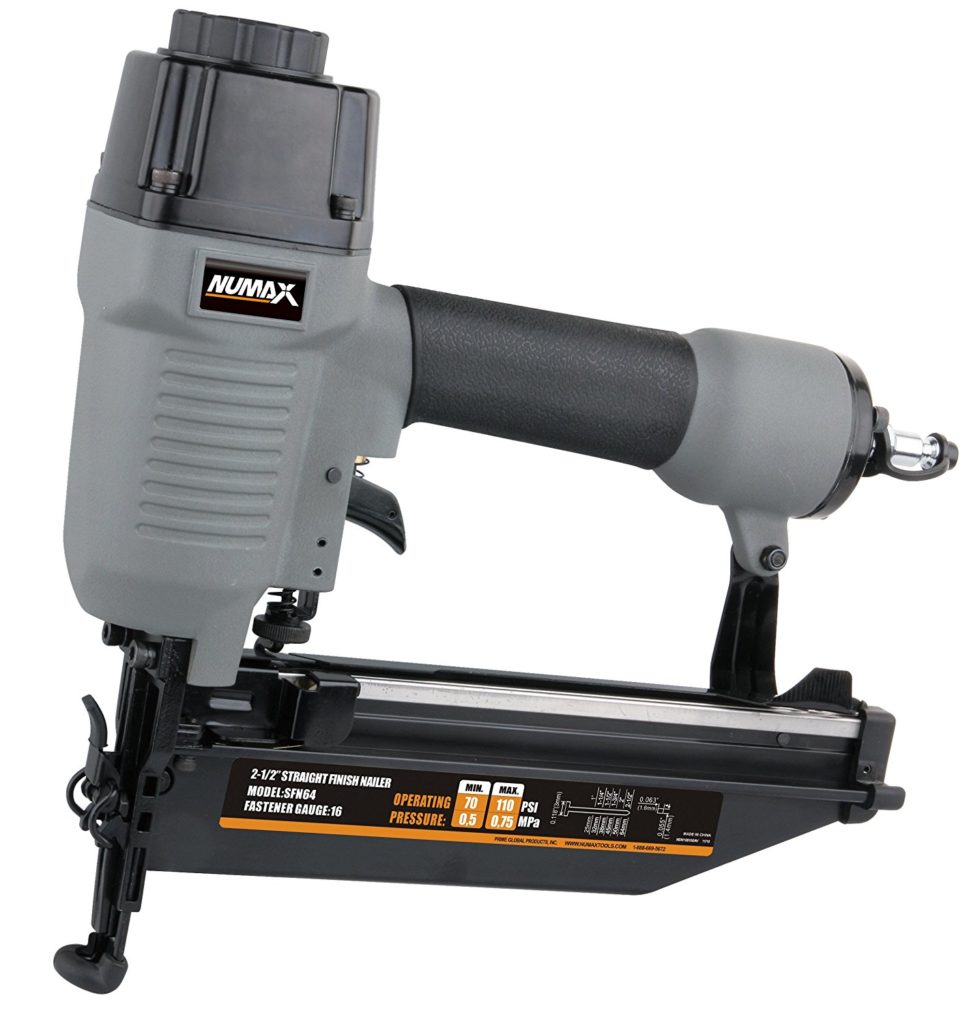 |
Pneumatic | Yes | Adjustable exhaust | >>Check the price<< |
 |
Pneumatic | Yes | Air duster | >>Check the price<< |
 |
Electric | Yes | N/A | >>Check the price<< |
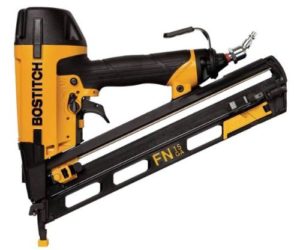 |
Pneumatic | Yes | 4 profile tips | >>Check the price<< |
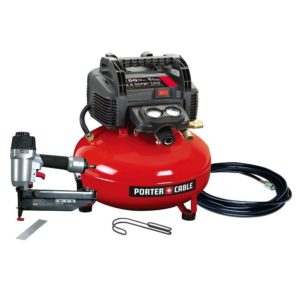 |
Pneumatic | Yes | N/A | >>Check the price<< |
 |
Electric | Yes | LED lights | >>Check the price<< |
Contents
- 1 What is a nail gun and what is used for
- 2 Nails & sizes
- 3 Difference between Brad Nailer and Finish Nailer
- 4 What to look for in a nailer
- 5 The reviews
- 6 Most common questions from buyers
- 6.1 What’s the use of a finishing nailer?
- 6.2 Which size of finishing nails do i need?
- 6.3 Do i need an air compressor for any kind of nailer?
- 6.4 What’s the difference between straight and angled finish nailer?
- 6.5 Can i use finish nailer for framing?
- 6.6 Why not just drive the nails with a regular hammer?
What is a nail gun and what is used for
A nailer or nail gun is a power-operated replacement to a hammer for pushing nails into hard surfaces. Now this power can be in form of compressed air, a fuel cell or a battery. If you have a project at hand which will require you to drive a lot of nails then it might be a good investment to get a nail gun instead of just making it work with a hammer. A nail gun can make the work easier, consistent and less time-consuming.
The most important advantages of a nail gun are its consistency and improvement in the time consumption. Our hands tend to get a bit wavy when we get tired and it affects our ability to keep the angle and force of hammering constant which consequently shows in a poor finishing. A nail gun especially a pneumatic one can eliminate this issue altogether given that its power source is stable. So, if you are looking to start a project at home or simply looking to pick up carpentry as a hobby or job it would be worth getting a nail gun.
In the past, it was used to be that only professionals such as contractors had nail guns and your normal everyday Joe used a hammer to drive his nails in place but these days the case is that the days of old-fashioned hammers are long gone. Nail guns have replaced hammers in our households and there are tons of them available in the market which elevates the need for an explanation of how things work, what suits your purpose well and which one you should get. Depending on the kind of project you have got in hand you are going to need a nail gun specific to that. You can also make do with a randomly picked nail gun but to get a decent and appreciable finish it is advised to choose a tool designed for your particular need.
Nails & sizes
Nail guns come in different sizes, so it is better to check whether you are picking the right one for the required job or not. They are classified according to the nail size. The number of nails that can be loaded to them is also an attribute that differentiates them from one another. Bigger the number smaller will be the nail is the basic principle when it comes to nails, for example, an 18-gauge nail is smaller than a 16-gauge nail.
The headless 23 gauge nail has a very small size and it is also known as the pin nail which is used in pin nailers. It’s mainly for nailing two wooden pieces together because they are so thin and tiny that they don’t offer a lot of anchorages and are mostly used along with glue to hold the pieces together. They are so small that it’s quite hard to tell if they have even been used, they usually mix in with the grain of the wood or can be easily obscured with varnish.
Moving up in size, there are staple guns. The staple guns offer more holding power but they are not as discreet as a pin or brad nail. They are very visible and that’s why they are mostly used on the back of wood works.
Continuing with the size theme, a brad nail would be next. A brad nail is an 18-gauge nail and is mostly used for nailing moldings, trim pieces in place. They have relatively bigger heads as compared to the almost non-existing heads of pin nails but still not as big that they would stick up like a sore thumb. Their heads can be hidden using a darker varnish. Their head provides more holding power which is why they can be used independently of glue.
Next up are finish nails. They come in gauge sizes 15 and 16. They are used for framing jobs, paneling, shelving etcetera. They are the most commonly used nails in household scenarios. If you are looking for a nail gun just to have it in the case then a finishing nailer is your best bet. Finish nails offer a lot of anchorage without leaving a big nasty mark in the wood. The small crater they leave can be easily filled and made flush which makes them ideal for framing jobs, especially where the nailing is being done on an eye level. A well-executed use of finish nails does not show up unless you are looking for it.
There are also two types of finish nailers, there is the usual one which is like any other nail gun and then there is an angled one. The angled one has its magazine rail at an angle which allows you to easily reach tight spaces such as corners and joints in your woodworks. There are also options available when it comes to finish nails, they come in two different types. There are the normal ones and then there are the sliced head ones.It’is up to the user preference and type of job to choose in between those. A cut or sliced head nail will offer a much cleaner finish without having to put much work into the varnishing and finishing process but due to its smaller head, it will offer less anchorage.
Next in the order are flooring nailers. These have a 7-gauge nail and are mostly used for flooring and heavy duty uses. They are quite visible and that’s why they are rarely used for projects. They are more of a commercial kind of nailers and that’s why you don’t have to bother about researching them unless your starting project is a flooring job. So, for regular home use a brad or finish nailer is good enough and you will be able to handle almost any kind of handy work or project with it.
Difference between Brad Nailer and Finish Nailer
Brad nailers and finish nailers belong to the same family. It can be said that brad nailers are a type of finish nailers. But there are a few differences. Brad nailers use 18-gauge nails whereas finish nailers use 15 and 16-gauge nails. Though the nails used for brad nailers are not technically nails, they are brads, hence the name.
A brad is a nail with a rectangular head. It’s usually small and more discreet but the small head of the nail means it offers less holding power. Brads are mostly suited for cases where the wood trim is thin and there is a chance of splitting if a larger nail is used or if you don’t want to work too hard to make the nail heads disappear. The rectangular shape allows the nails to mix in with the grain, they do show but only if you are looking hard for them, a strategically applied layer of varnish can easily cover them up without the need of any filler.
Finish nailers, on the other hand, use proper nails and that’s why offer a lot more holding power. You can attach things to the walls using finish nails and they will hold up just fine as long as you find the stud while putting up your shelves or whatever. Finish nailers are commonly used for installing frames for windows, doors and for putting up more heavy things such as shelves. Due to the large nail gauge, they offer a lot more holding power but this has disadvantages too, you can easily split a trim piece that is thin with a finish nailer. So just to be on the safe side a finish nailer should only be used for jobs that include studs or wood pieces that are at least one inch thick.
It’s really up to you to decide which nailer you need. Finish nailers are much more versatile but they have their limitations. Similarly, a brad nailer may offer you an easy to perfect finish but they cannot offer the same holding power or anchorage over a finish nailer. If you just want to get a nailer on the case you might need it then a finish nailer is a way to go but if you have a certain art project which requires you to nail together different small and thin pieces of wood a brad nailer would be a much better choice.
What to look for in a nailer
The market is awash with options when it comes to finish nailers. Although it is a good practice to do the due diligence and dedicate enough time towards research so that you don’t end up with a tool which is not according to your liking and instead of making work easier it just frustrates you. There are a few must-have features that a finish nailer should have to ensure that you have the best of experiences and don’t end up with a ruined project or worse with an injury.
-
Jam Clearing
For starters, a finish nailer should have an automatic nail clearing feature so that if a nail gets stuck in the magazine you can easily and safely extract it without having to run around looking for an appropriate tool. A quick jam clearing adds to the value of a nailer.
-
Depth Adjuster
Continuing with the tool-free theme, a finish nailer should have a tool-less nail depth adjuster. This feature will give you the option of presetting the depth at which you want your nail to be driven. If it’s a job that requires a smooth glassy finish then you can set the nailer to drive your nails real deep so that you can fill the divots left later on with some wood putty before varnishing. Also, if you want the nails to be left a bit higher instead of flush with the surface you are working on, you can do that too using this feature.
-
Comfortable grip
Another important aspect of a finish nailer is its grip, a finish nailer should have a grip that’s comfortable and provides you with an affirmative hold over the tool so that you can be safe too. An angled finish nailer is also something to be looked at if you have to work in corners such as putting up crown moldings, it’s not a must-have feature but if the user is inexperienced then it is not a good idea to use a normal finish nailer and produce angles with it as it increases the chance of nail slipping.
-
Onboard air adjuster
Another nice to have feature is to have an onboard air duster, this can help you with clearing sawdust or other such debris before you start nailing. It is extremely helpful if you marked out spot and now they are covered in sawdust.
-
Adjustable air exhaust
Another nice feature that all the good finish nailers nowadays have is an adjustable air exhaust, you can angle the air coming out away from your face using this feature. This way you won’t get any debris or dust into your eyes.
-
Adjustable Triggering
A feature that is often neglected is the ability to switch between sequential and Bump fire mode, you might be asking what those modes are, well in bump mode you just have to press the gun against the surface you want to nail while keeping the trigger squeezed and the gun will fire a nail each time you press it against the surface whereas in sequential mode you have to squeeze the trigger every time you want to punch in a nail.
-
Dry Fire Control
Another feature that is important is the guns ability to tell when it is empty. This helps with keeping the finish clean because if the gun doesn’t have an auto-stop feature when its empty then it will keep firing and the plunger will keep up its regular motion which will result in it hitting the surface you are working on which will leave marks in the wood without any nails being actually driven. Dry firing is also not very good for the gun and it can cause problems if it’s done over and over.
-
Power source
Most popular option here is pneumatic nailer. It works by using compressed air and needs an air compressor to operate, which you should buy separately. The nail gun connects to the compressor via air hose. You can also use a cordless finishing nailer. In this case, it will be either battery or fuel-powered. Battery powered nail gun requires a charged battery to operate. Fuel powered nail gun needs both battery and a fuel cell to do its job.
The reviews
In the following discussion, we have accumulated a few nailer reviews that will hopefully help you out in choosing a finish nailer that might be perfect for you.
NuMax SFN64

NuMax SFN64 is a great tool for handling interior finishing jobs. It can fire 16-gauge nails ranging from 1 to 2 ½ inch in length. This makes the NuMax SFN64 ideal for jobs that are wood on wood, such as furniture, crown molding, shoe molding, baseboards etcetera.
The NuMax SFN64 comes with a quick jam release mechanism which enables you to clear jammed nails with ease and without the need of another tool. Another must-have feature that the NuMax SFN64 does have is an adjustable depth nose, this enables you to get a smooth finish on all surfaces.
Overall, it’s a great tool that offers good value for the money. NuMax SFN64 is suitable for back to back nailing for long durations as you can load up to hundred nails in its magazine and carry on working instead of stopping in the middle to reload the magazine with finish nails. It is an air powered nailer and specially designed to last in your arsenal for years with a tough aluminum body and strong cylinder.
Hitachi NT65MA4
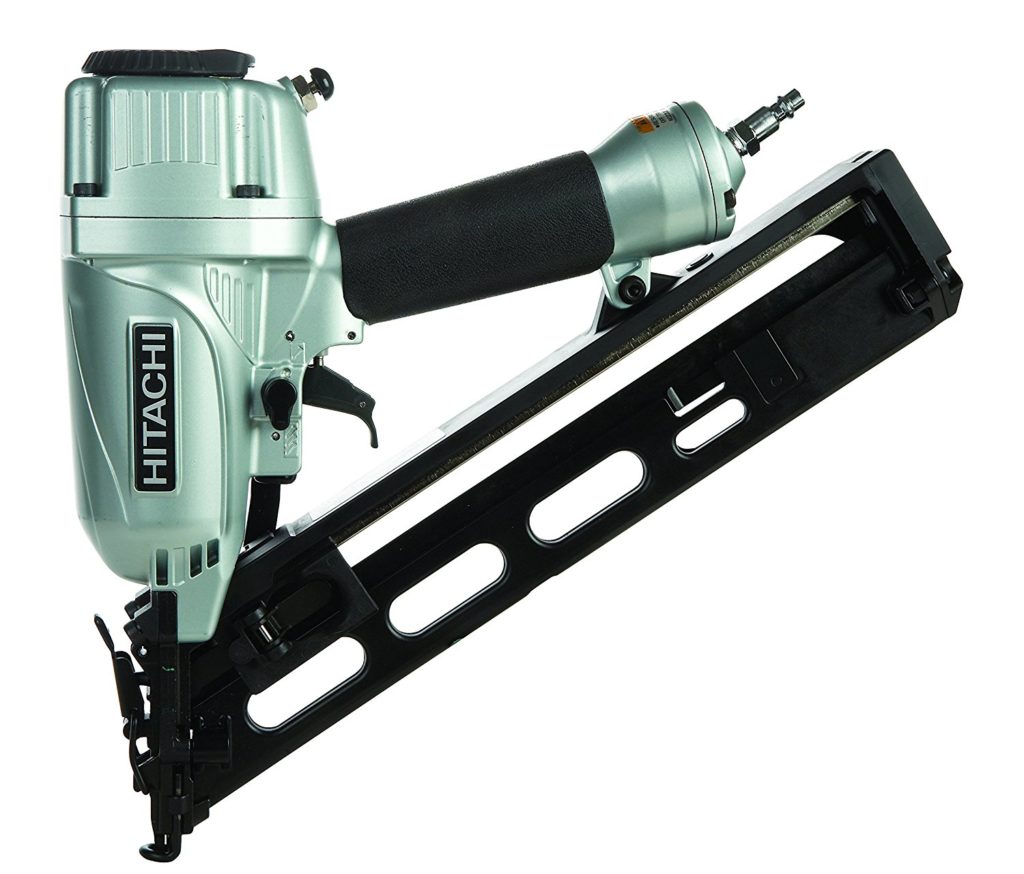
The Hitachi NT65MA4 is one of the industry leading nailer available on the market. It uses a 15-gauge nail and can accommodate nails ranging from 1-1/4 inch to 2-1/2 inch. It offers all the essential features that you might expect from a finish nailer.
It is oriented towards the ease of usability and safety of the user. It comes with an easy to clear nose for quick nail extraction in case of a nail jamming, this means that you don’t have to struggle with it to get a stuck nail out and use tools that might damage the nose of nailer or hurt you. It also comes with an integrated air duster that allows you to blow away any sawdust or debris from the surface you are working on.
The Hitachi NT65MA4 allows you to adjust the depth of nails you might be driving. You don’t need any tool for that it’s an easy to access dial that allows you to do so. The rubber grip and the 360-degree adjustable exhaust are just a few of many features that make the Hitachi NT65MA4 a very good choice for you.
Paslode 902400

The Paslode 902400 is a cordless beast that can perform just as good as its pneumatic rivals. It offers all the workability of a finish nailer without the inconvenience of dealing with the annoyance of an air hose. It is portable and does not rely on an air compressor to be powered which makes it perfect for keeping it in your work truck or a usual household which in all probability won’t have an air compressor. Its powered by lithium-ion batteries that are easy to swap out and install.
The Paslode 902400 is lightweight which makes it easy to handle and especially helps in cases where you have to hold it above your head and your arms are getting stressed. It’s an angled finishing nailer which makes it ideal for corners and tight spaces. The Paslode 902400 offers excellent visibility around its nose which makes you more efficient and clean in your work. It offers pro-grade adjustability when it comes to adjusting the depth of the nail being driven.
The build quality is marvelous and it can withstand the abuse it may face in a work environment. The handle has been designed with comfort and a nice grip in mind. The angle has been worked so that it doesn’t cause your wrist to be in an uncomfortable position for a long period of time.
BOSTITCH N62FNK-2
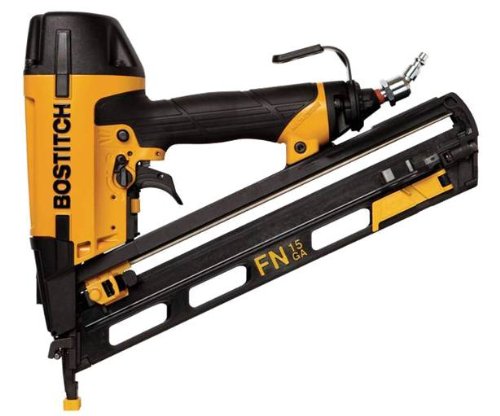
The BOSTITCH N62FNK-2 is another 15-gauge finish nailer. Its oil-free and the magazine is designed to be at an angle. It handles nails from 1 ¼ inch to 2 ½ inch which makes it ideal for framing jobs and other such things. The BOSTITCH N62FNK-2 also offer tool-less nail removal so that you can get rid of any stuck nail without fighting with the nailer.
The nail depth can be controlled easily without the need of any tool all you have to do is just turn the adjuster clock or anti-clockwise. The housing of the tool is made up of magnesium which makes it ultra-lightweight while giving the durability of industrial grade.
The Lightweight makes the BOSTITCH N62FNK-2 an ideal choice for an everyday user. The angled air hose fitting makes life just a little bit easier too. This enables you to keep the air hose out of your way especially if you are working with the tool above your head the angled air hose fitting will enable the air hose to follow the line of your elbow, as in the air hose will be parallel to your arm.
PORTER CABLE PCFP72671 Finish Nailer/Compressor Combo Kit

PORTER-CABLE PCFP72671 is much more than just a finishing nailer. It’s a complete package that includes an air compressor, a finish nailer, air hose and all the needed fittings. The finish nailer uses standard 16-gauge nails that can be 1 to 2 ½ inch in length.
The pump, that is included, is 6 gallons in capacity and can provide compression up to 150 psi. The whole setup is maintenance free which makes it convenient for average users. The compressor runs on 120V which makes it ideal for home use. It can also be rigged to run on a car’s alternator with the proper electrical converters. The hose is 25 feet long which makes the user experience awesome as you don’t have to worry about the compressor you can just hook up your nail gun and get to work.
DEWALT DC618K XRP
 The DEWALT DC618K XRP is another cordless finish nailer. It runs on 18 Volt batteries. The cordless feature enables you to take your nailer with you anywhere you might desire and for that purpose, the DEWALT DC618K XRP comes with its own case, this means you can take it anywhere and not have to worry about damaging the nose or the magazine.
The DEWALT DC618K XRP is another cordless finish nailer. It runs on 18 Volt batteries. The cordless feature enables you to take your nailer with you anywhere you might desire and for that purpose, the DEWALT DC618K XRP comes with its own case, this means you can take it anywhere and not have to worry about damaging the nose or the magazine.
The DEWALT DC618K XRP offers all the feature you might be looking for in your next finish nailer. Features like the ability to clear nails without the help of any tool or adjusting the nail depth independent of any tool. The tool offers you a choice between sequential mode and bump fire mode. The bump mode allows you to make remarkable progress. The DEWALT DC618K XRP also includes integrated LED lights. Overall, it’s a good choice any day of the week.
Most common questions from buyers
Here are the list of questions you may have if you looking for a finishing nail gun.
What’s the use of a finishing nailer?
These tools are primarily used for finishing off the finer detail work of mostly wooden or ply board applications. Their thin nails can be driven through the trim board and into soft and hardwoods. The best thing about finish nailers are they leave behind a very small footprint which can be filled in easily for a smoother finish.
These nailers have safety noses that need to be depressed before they are triggered and their no mar tips prevent the nailer from damaging the surface you are working on. Basically a finish nailer is a smaller version of their standard nail gun counter parts.
Which size of finishing nails do i need?
The gauge of a finish nail is actually a measure of its diameter, just like with electrical wire. The higher the number, the thinner the nail is; the lower the number, the thicker it is.
15- and 16-gauge nailers are the real anchors of the pneumatic-trim-nailer team. These two tools fire nails up to 2-1/2 inches long, and are the most versatile for interior carpentry. They also have quite a bit of overlap in terms of application. Both are commonly used for installing baseboard, chair rail, door and window casing, crown molding, door frames, and more. One advantage to 15-gauge nails is that they are collated at an angle, which allows the nose of the nailer to reach into tighter spaces. But if you really can’t decide which to choose, consider getting a combo kit which gives you more than one size gun all in the same package.
Do i need an air compressor for any kind of nailer?
Although most nail guns available on the market are air-powered, there are battery-powered nailers available as well. They don’t need an air compressor to operate, just a charged battery, or sometimes a fuel cell and battery.
What’s the difference between straight and angled finish nailer?
The angled nailers usually have heavier gauged nails and are designed to get into tighter areas. The straight nailers have finer nails and are used more for exposed surfaces so you don’t see the nailhead as much as you would the angled one. Basically you need to decide what the applications you plan to use it for and decide which would better perform for you.
Can i use finish nailer for framing?
A finish nailer won’t give you the strength you need. Normal stud framing would use 16d sinkers, which are a LOT larger than any finish nail you would shoot.
On the topic of buying a framing nailer, I have a friend who’s a carpenter and when I was looking into the same thing awhile back his advice was to not mess around with a framing nailer. They are heavy duty tools, not really meant for the average do-it-yourselfers.
The best advice is to go rent a framing nailer and apply safety rules in operation of the equipment. Home Depot can provide what you need from proper use and at a reasonable cost versus buying. You already have the compressor. You’ll get the job done faster and more holding power than you finish nails. Screws are nice to use on the right things but framing is another issue. Wear protective eyewear and don’t nail into knots!
Why not just drive the nails with a regular hammer?
While you should always have a hammer and nails at the ready, they shouldn’t be your only choice for framing. While walking plates to nail joists or rafters, sometimes I will spike in a couple of handrives, just so I don’t have that hose dragging around behind me, and the time difference is minimal as opposed to a gun in these situations. For nailing walls, or anything that requires one hand on the board and one hand on the trigger, guns are the way to go.
Sometimes when laminating a couple of members together, I will pin the safety and leave the head proud, so that I can drive it in with my hammer to tighten it up a bit. I am also finding myself with a pouch full of 3″ deckmates and an impact handy for those stubborn pieces that come along. And like somebody else said, it’s not the tool that makes a clean frame, it’s the operator.
